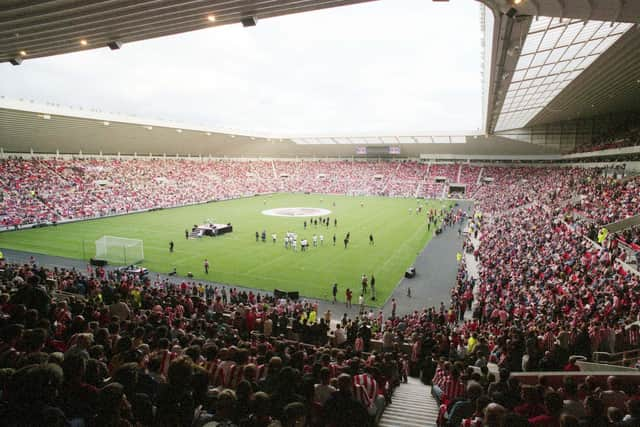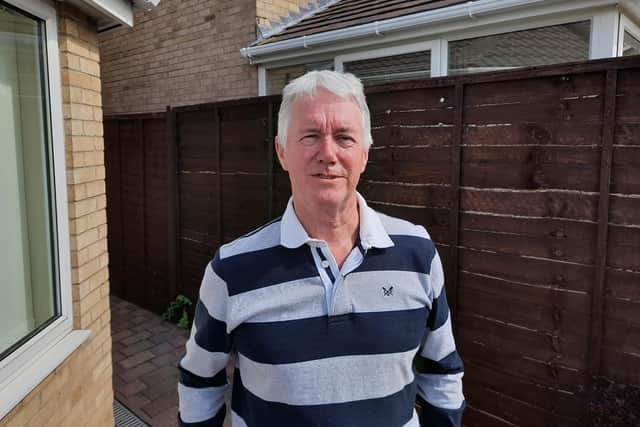Meet the man who built Sunderland's Stadium of Light as ground reaches 25th anniversary
and live on Freeview channel 276
Sunderland’s friendly against Dutch giants Ajax is remembered more for the incredible effort involved just to play the fixture than the game itself; a nil-nil draw.
Workplaces and pubs across Wearside were consumed with gossip of how Sunderland AFC would, embarrassingly, have to cancel the match. “Experts” had peeked through the fence to reach this conclusion.
Advertisement
Hide AdAdvertisement
Hide AdFortunately a real expert was in charge. Meet the man who built the stadium but was never given proper credit; civil engineer Dave Nicholson.


Your humble reporter was employed by the club then and was literally right next to him, his sidekick if you will, very often in a state of amazement. I have worked with some excellent people in a mixture of industries, but never been more impressed in a work environment than I was by this man.
He was project manager during the building, becoming stadium manager when the ground opened. Lesser types would have fled.
But amid a maelstrom of setbacks and let-downs Dave remained calm. Just as well with a host of inspectors, as well as thousands of supporters breathing down his neck.
Advertisement
Hide AdAdvertisement
Hide AdYou may remember him on Premier Passions, telling a bewildered interviewer hours before the game: “You see chaos, I see progress.”


Dave, now 66 and living in Ingleby Barwick, said: “Initially I was self-employed. I was the site-based project manager representing the client; Sunderland Football Club. I’d been a project manager for the Teesside Development Corporation on the Tees Barrage.”
The Ajax game went uncomfortably close to deadline. Why?
Dave explained: “The nub of it was that it was design-and-build. You design today what you’re building today, which, if you’re building a factory or school, it’s reasonably straightforward.
“But with a football stadium, where you have to satisfy so many people, it becomes more complicated. The Tees Barrage was design-and-build, but it was much simpler.
Advertisement
Hide AdAdvertisement
Hide Ad“Essentially we were designing it as we built it. In designing it you have to make sure it’s what the client wants, satisfy the safety authorities, Building Control and many others besides.”
This was to seriously threaten the grand opening; something which did not bear thinking about.
Dave continued: “Securing the safety certificate went to the wire. The stadium wasn’t finished. I took the safety people round the parts where no building was being done. The unfinished parts weren’t in use. So we got the certificate.
“The safety people wanted reassurances that we had built what we said we would and were complying with regulations.
Advertisement
Hide AdAdvertisement
Hide Ad“You look at safety of life. So things like the PA system, fire system, fire detection, stewarding; all that had to be visible and working.”
The day before kick-off the club didn’t even have a licence to sell alcohol, although not having one would have actually made Dave’s life easier at that point.
The police didn’t want the licence to be given as the stadium’s custody suite (nick) was incomplete. As this was due to the police not telling the club what they wanted, this seemed a little unreasonable. Dave mentioned this to the magistrate, who granted the licence.
Dave was pleased with this, until he realised that he was the licensee.
Advertisement
Hide AdAdvertisement
Hide AdThe top floor of the West Stand was a shell when Ajax came to town. Outside the stadium a hardcore surface was quickly covered with tarmac; then dug up again the morning after the game.
Someone fell down a manhole which had been accidentally tarmacked over. He wasn’t hurt. A million things seemed to go wrong.
Dave continued: “When I got back from the magistrates I was informed that we didn’t have any hoovers. The builders had locked them away. So we had a load of cleaners and no hoovers.
“The builders themselves had a table in the lounge; and they complained because there was sawdust on the floor!”
Advertisement
Hide AdAdvertisement
Hide AdThe safety certificate was granted about as late as was possible.
Dave said: “We had to go to the council chamber. Although you got a safety certificate from the FA, it was actually the local authority who issued it.
“A lawyer for the council asked me to tell him the stadium was safe. I told him it was. He then asked (director) John Fickling and (safety officer) John Davidson the same question and they gave the same answer. The lawyer was switching it back to us. If anything had gone wrong it would have been on us.
“The lead-up to the game was… quite busy. The builders handed over the stadium to the club at noon. It was handed back to the builders the next morning.”
Advertisement
Hide AdAdvertisement
Hide AdDave acknowledges immense help in 1997 from Northumbria Police and Sunderland City Council, particularly “Ken Scott from Building Control. A brilliant bloke.”
Many fans remember the ticketing issues. This was compounded when seat rows were wrongly numbered (we know who did this, but won’t give a name).
A man in a Sunderland shirt appeared in the match control room. Everyone thought he was with someone else. He’d just wandered in there. Lager was dripping into the home dressing room. Yet ultimately the event went well, albeit not exactly seamlessly.
Dave said: “I honestly would have liked another month. But there was absolutely no issue with safety.”
Advertisement
Hide AdAdvertisement
Hide AdHaving built the stadium, he then as stadium manager had to learn how to use it. The systems he put in place for match-days are still used today.
He left the club amicably in May 2000, the board reluctantly accepting his resignation. They didn’t really know what Dave and his department did. But they knew that it worked.
He recently returned to the stadium for a gig. His wife Pam (they now have five grandchildren) asked him what his feelings were.
Dave replied: “None really. For me it was all about the people.”